
Researchers claim to have found a method to break up “forever chemicals”, or PFAS, into smaller and less harmful compounds in drinking water. The technique could be added to the water purification process to prevent the concerning build-up of these chemicals in our water supply, as more research highlights possible health problems associated with PFAS ingestion.
Perfluoroalkyl and Polyfluoroalkyl Substances (PFAS) are chemicals that do not degrade naturally in the environment and are extremely difficult to break down due to their strong chemical bonds. However, what makes them so problematic is what also makes them so useful – their impressive stability makes them incredibly useful in industrial applications, and there are currently around 4,700 members of the PFAS family across a range of manufacturing processes. They are present in food packaging, cookware, clothing, carpets, makeup, and much more; trying to get rid of them at this point would be a task greater than the banning of CFCs in 1994.
According to a Californian analysis, almost all people tested in one study had PFAS in their blood.
So, it should be cause for alarm when recent studies have discovered that the specific PFAS they looked at (which is a very small selection) are harmful to both humans and wildlife, and love to aggregate together to become even more problematic. They are being pumped into waterways and oceans, soil, and forests, causing harm to local wildlife – but once they are there, they will never leave without some large-scale human intervention.
In an attempt to stop this problem in our drinking water, scientists from University of California, Riverside, have developed a way to break these forever chemicals down in drinking water using ultraviolet (UV) light.
First, the water is mixed with hydrogen to make the PFAS more reactive, before being subjected to high-energy UV which helps reactions to destroy the pollutants. Not only are the problematic carbon-fluoride bonds broken, but the reactions turn the PFAS into byproducts that are thought to be harmless. According to the research, almost 100 percent of the PFAS were destroyed.
The researchers are now looking to further improve the technology, which is patent-pending, in the hopes it can go into widespread use.
“We are optimizing it by trying to make this technology versatile for a wide range of PFAS-contaminated source waters,” co-author Haizhou Liu said in a statement.
“The technology has shown very promising results in the destruction of PFAS in both drinking water and different types of industrial wastewater.”
The research was published in Journal of Hazardous Materials Letters.
Source Link: New Method To Destroy "Forever Chemicals" In Drinking Water Created